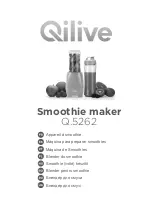
Instruction
For customer support,please call
Email us at [email protected]
PAGE 1
Safety and Use Instructions
Read, understand, and follow all Safety and Use Instructions to avoid
injury.
handles.
WARNING
• Keep children away from the stove while cooking. Be careful around
burns.
• Never allow cookware to boil dry or leave an empty cookware on a
hot burner, as the cookware can get extremely hot. This could lead
to warping or damage of the non-stick coating.
• Do not overheat your non-stick cookware, as smoke or fumes from
burning foods, oils, and non-stick coating can be hazardous.
damage the exterior of the cookware and handle, voiding the
guarantee.
Instruction Manual
3PLY Laser Nonstick
Stainless Steel Frypan Set
use a vinegar solution of equal parts
water and vinegar. Apply vinegar
solution with sponge or cloth.
Allow to sit for 10 minutes. Rinse
and dry completely.
with hot soapy water to ensure it is clean; cookware and lid
are dishwasher-safe. Dry completely before storing.
• Do not use abrasive cleansers like steel wool, cleansers with
chlorine bleach, or oven cleaning solutions as they may
permanently damage the cookware and void the guarantee.
• To deep clean...
the cookware (not the area
with nonstick)
use a nonabrasive sponge or cloth
to deep clean.
For tougher food buildup or
occasional deep cleaning, prepare
a baking soda paste by mixing 1/2
cup (125 mL) of baking soda with 3
tbsp (45 mL) of water. Apply to the
desired areas and let it stand for
paste, rinse thoroughly, and towel
dry.
periodically clean with a cloth
dampened with vinegar or lemon
juice. Rinse and dry completely.
use a stainless-steel cleanser to
restore the luster and remove
buildup and discoloration.
cookware
To maintain a clean and shiny lid
To remove water spots or
discoloration
I. CLEANING
1−2
Storing
To help reduce scratches on interior and exterior coatings,
between cookware when storing.
Stovetop use
Cookware may be used on a glass or ceramic cooktop,
electric coil, gas burner range, or induction range. Exterior
surfaces of cookware and induction, glass top, and
ceramic cooking surfaces should be clean and free of
food residue before heating. Consult your stove
manufacturer's instructions for more details.
• Select a burner size that matches the diameter of the
extend beyond the base of cookware.
• Use appropriate heat level for cooking application.
Overheating cookware can cause discoloration.
Discoloration (blue-colored tint on exterior surface)
Non-stick
Always use low or medium heat when
cooking food. This helps preserve the
nutrients in food (many of which are
fragile, and easily damaged when heated
to extremes). It also helps preserve the
nonstick surface.
Low heat
Simmering liquids, warming food, and
preparing delicate sauces.
Medium heat
Preheating, sautéing, searing, frying,
stir-frying, maintaining a boil.
High heat
Boiling and reducing liquids only.
II. USE AND CARE
For best results when sautéing or searing, preheat cookware
before adding food, but do not preheat empty cookware:
• Before you begin cooking, add a small amount of cooking
oil (Note: aerosol non-stick sprays are not recommended
if not washed promptly or overheated). Preheat for
1−2
minutes on medium to medium-high heat. Add food and
• Add salt to liquids once a boil is reached. Salt will not
absorb into cold water and may leave small white marks
on the stainless surface. Salt should be added to foods
toward the end of cooking.
Oven use
Broiler use
Cookware is oven-safe to 500°F (260°C). Glass lid is
oven-safe to 500°F (260°C).
Never place this product under the broiler. The nonstick
coating will be severely damaged and it will void the
warranty.
Microwave
and outdoor
grill
Not microwave or outdoor grill-safe.
Non-stick
sprays and
oils
Do not use non-stick sprays on the cookware as they
cause an invisible buildup and impair the nonstick coating
of the nonstick and result in a reduced life of the coating.
Utensils
Nylon, wooden, and plastic tools are recommended to
maintain beauty of the stainless steel. Metal whisks and
non-sharp metal utensils can be used, but may scratch the
surface. In time, stainless will show wear from normal use.




















